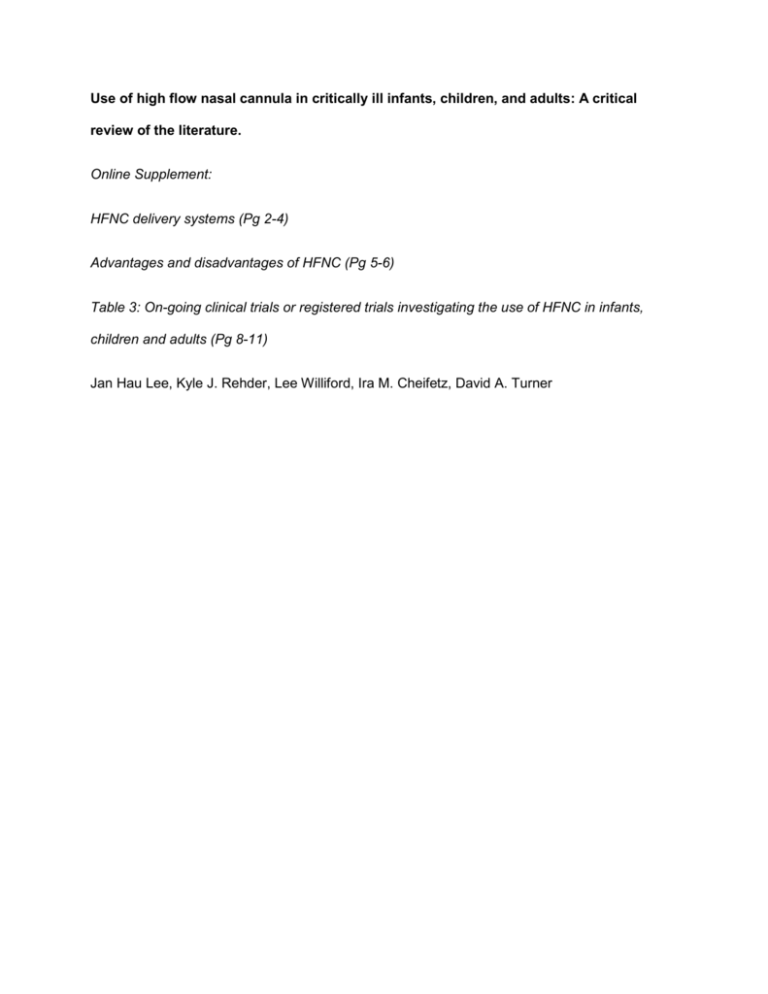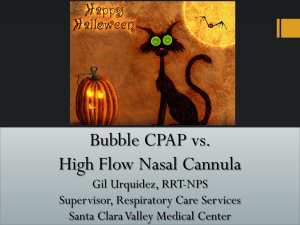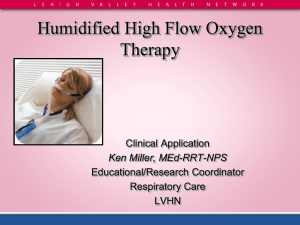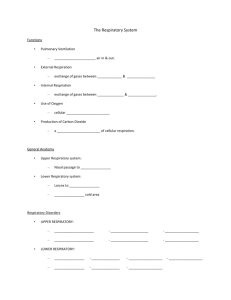Use of high flow nasal cannula in critically ill infants, children, and
advertisement

Use of high flow nasal cannula in critically ill infants, children, and adults: A critical review of the literature. Online Supplement: HFNC delivery systems (Pg 2-4) Advantages and disadvantages of HFNC (Pg 5-6) Table 3: On-going clinical trials or registered trials investigating the use of HFNC in infants, children and adults (Pg 8-11) Jan Hau Lee, Kyle J. Rehder, Lee Williford, Ira M. Cheifetz, David A. Turner HFNC delivery systems. Bubble humidification is the most common method for humidification of gas flow via standard nasal cannula. However, this approach is generally not sufficient with higher gas flow rates due to decreased hygrometric properties of the gas as well as decreased patient comfort [1, 2] . Newer devices that can effectively handle high gas flows have been developed. The basic set-up required for HFNC is a gas source to generate the necessary flow, a heated humidification device that can handle high gas flow rates, often a pressure release valve, connection tubing and an interface that will fit comfortably in the nares (Figure 1). There are numerous high flow delivery systems commercially available [3-6]. These systems share common characteristics. All can deliver flow rates greater than 30 lpm; some models can deliver flow rates to up 60 lpm [2-5, 7]. They all achieve 95-100% relative humidity at 30-40oC by mixing the inflow of gas with heated water vapor in the humidification systems. Some have a proprietary semi-permeable membrane that separates inflowing gas from the heated water allowing only heated vapor to mix with the gas, while others allow for a common chamber between inflowing gas, heated water and vapor [2, 3, 7] . The various manufacturers have unique compatible nasal cannula sizes and interfaces that fit their own humidifiers. Nasal cannulae are available for sizes ranging from premature infants to adults. One major difference between systems is the presence of a pressure release valve (Figure 1). The need for such a valve is not universally accepted. Comparing two HFNC systems (up to 12 lpm) in an in-vitro lung model, Hasan and Habib [8] measured pressures generated in 3 different locations in the HFNC setup at increasing distance from the flow source. Between the system with and without a pressure release valve, there was a 15 cm H2O difference in positive pressure measured at the device (most proximal to the flow source); however, a much lower difference in pressure was found at the nasal prongs (6cm H2O) and the proximal upper airway(3 cm H2O). The proximal upper airway pressure is most clinically relevant and such a degree of difference is likely to be most important in smaller and younger patients. The pressure release valve, allowing control of the maximal pressure generation at the device (below 35 cm H2O) is considered by many to be a desirable safety feature to minimize the risk of a sudden increase in airway pressure. This study showed that the presence of such a valve limited the positive pressure at the proximal airways to < 6 cm H2O. Because of this finding, we extrapolate that pressure release valve systems may be more useful when airleak syndrome is of concern, such as the neonatal population. There are currently no in-vivo studies to allow us to comment on the clinical significance of the presence of a release valve and whether such a clinically significant difference in airway pressure is present in patients using different HFNC systems. Some HFNC systems have gas blenders for accurate and consistent blending of inspired oxygen [3, 5, 7]. Gas titration is particularly important in premature infants in whom oxygen toxicity is of concern, children with shunt-dependent congenital heart diseases, and in COPD patients in whom respiratory drive is driven by relative hypoxemia. Therapeutic inhaled gases can also be blended together with HFNC. For example, nitric oxide has been used with HFNC in patients with pulmonary hypertension [9], while heliox with HFNC can be used in patients with airway diseases [10]. Important considerations in this context are the impact of such high humidification on the intrinsic properties (such as density and/or viscosity) of these gas mixtures and vice versa. Intrinsic properties of gas mixtures such as high thermal conductivity of helium may affect the heating mechanism in HFNC systems, but to our knowledge, there are no studies addressing these potential issues. In addition, the very high flow rates used with HFNC limit the duration in which these therapeutic gases can be utilized, necessitating frequent tank changes and increasing costs. In addition to the administration of therapeutic gases (such as helium [10] and nitric oxide [9]) via HFNC, aerosol delivery of drugs can be administered via HFNC. However, the increased flow rates may substantially affect medication delivery. Ari et al. [11] studied the in-vitro effect of heliox and oxygen in the delivery of albuterol using HFNC. Their finding showed that with 100% oxygen, increasing gas flow from 3 to 6 lpm, resulted in less albuterol delivered (11% to 2%), but this marked decreased in albuterol delivery was improved with the introduction of 80% helium (11% to 5%). This interesting finding should be kept in mind for clinical application and future studies looking at administration of aerosolized drugs with HFNC. A higher dose of medication or the addition of helium may be required to ensure adequate medication delivery. Based on the available data, it seems reasonable to recommend that if an aerosolized medication is deemed necessary in a patient supported with HFNC, it should likely be delivered using conventional mask techniques. Additional investigations are needed before more definitive recommendations can be made. There are no studies to date to show superiority of one HFNC system over another. The decision on which HFNC system to acquire for clinical use is likely to be driven by the overall cost of the systems, clinical preference on the need for a pressure release valve, the allied health and engineering support available, and the local availability of the respective humidifiers and HFNC systems in different countries and clinical settings. Of note, newer designs have also allowed HFNC to be adapted for use in lower-acuity clinical environments, including the home setting [7]. In clinical scenarios where superiority of HFNC is not well demonstrated, due consideration should be given to the costs of the overall setup for HFNC (including consumables such as vapor cartridges) relative to standard nasal cannula and NIV apparatus before deciding on the best mode of respiratory support. Advantages and disadvantages of HFNC. The importance of warming and humidifying gas to support respiration has long been established [12]. Humidification optimizes mucociliary clearance, improves secretion quality, and maintains normal mucosal function [13, 14]. Infants ventilated with ambient air that is not warmed or humidified have significantly decreased pulmonary compliance and airway conductance. [15] HFNC systems have the distinct advantage of being able to “decouple” the need to achieve high humidity with high flow. These systems maintain high humidity despite using relatively lower flow rates, in contrast to bubble humidifiers which lose effectiveness at high flow rates. The proposed advantage of HFNC reducing the metabolic cost of warming and humidifying inspiratory air is a theoretical one which has not been shown in any bench or clinical study [16]. Despite proper humidification, patients may still experience discomfort with HFNC, albeit much less often than with less-highly humidified delivery. [1, 17, 18] This subjective sensation of improvement of dryness on HFNC was supported by blinded assessment of the upper airway mucosa by otorhinolaryngologists [18]. However, to our knowledge, there are no studies comparing patient comfort and tolerance with HFNC versus mask-based NIV devices. Such studies would provide valuable information for clinicians in an attempt to optimize patient comfort and cooperation. In any water-based humidification system, there is always a risk of nosocomial infection. In 2005, a HFNC device was associated with increased Ralstonia pickettii bacteremia [19] and was recalled briefly from the market. After redesign of the humidifiers, there have been no further reports of associated infections. Given that HFNC can potentially generate positive pressure in the airway, airleak syndromes are a theoretical risk associated with use of these devices. A single case report describes a 26 week gestational age premature infant who developed subcutaneous scalp emphysema with pneumo-orbitis and pneumocephalus after being supported with HFNC of 4 lpm [20] . It is likely that the very low birth weight, premature infant population is at most risk of air leak with HFNC. The lack of pressure monitoring available in HFNC systems and inconsistency of pressure generated may further compound this issue, however, we are not aware of additional reports of air leak syndromes associated with HFNC. REFERENCES. 1. 2. 3. 4. 5. 6. 7. 8. 9. 10. 11. 12. 13. 14. 15. 16. 17. 18. 19. Chanques G, Constantin JM, Sauter M, Jung B, Sebbane M, Verzilli D, Lefrant JY, and Jaber S (2009) Discomfort associated with underhumidified high-flow oxygen therapy in critically ill patients. Intensive Care Med 35(6): 996-1003. Waugh JB and Granger WM (2004) An evaluation of 2 new devices for nasal high-flow gas therapy. Respir Care 49(8): 902-6. Fisher & Paykel (2012). [cited 2012 February 22nd]; Available from: http://www.fphcare.com/. Smiths Medical (2012). [cited 2012 28th March]; Available from: http://www.smithsmedical.com/. Hydrate Inc (2010). [cited March 28th 2012]; Available from: http://hydrateinc.com/index.php. Vapotherm (2012) [cited February 18th 2012]; Available from: http://www.vtherm.com/. DeLay PD, Stone SS, Karzon DT, Katz S, and Enders J (1965) Clinical and immune response of alien hosts to inoculation with measles, rinderpest, and canine distemper viruses. Am J Vet Res 26(115): 1359-73. Hasan RA and Habib RH (2011) Effects of flow rate and airleak at the nares and mouth opening on positive distending pressure delivery using commercially available high-flow nasal cannula systems: a lung model study. Pediatr Crit Care Med 12(1): e29-33. Huang J and Fridman D (2011) High flow oxygen and low dose inhaled nitric oxide in a case of severe pulmonary hypertension and obstructive shock. Chest 140(4). Kim IK, Phrampus E, Sikes K, Pendleton J, Saville A, Corcoran T, Gracely E, and Venkataraman S (2011) Helium-oxygen therapy for infants with bronchiolitis: a randomized controlled trial. Arch Pediatr Adolesc Med 165(12): 1115-22. Ari A, Harwood R, Sheard M, Dailey P, and Fink JB (2011) In vitro comparison of heliox and oxygen in aerosol delivery using pediatric high flow nasal cannula. Pediatr Pulmonol 46(8): 795801. Williams R, Rankin N, Smith T, Galler D, and Seakins P (1996) Relationship between the humidity and temperature of inspired gas and the function of the airway mucosa. Crit Care Med 24(11): 1920-9. Kilgour E, Rankin N, Ryan S, and Pack R (2004) Mucociliary function deteriorates in the clinical range of inspired air temperature and humidity. Intensive Care Med 30(7): 1491-4. Nakagawa NK, Macchione M, Petrolino HMS, Guimaraes ET, King M, Saldiva PHN, and Lorenzi G (2000) Effects of a heat and moisture exchanger and a heated humidifier on respiratory mucus in patients undergoing mechanical ventilation. Crit Care Med 28(2): 312-317. Greenspan JS, Wolfson MR, and Shaffer TH (1991) Airway responsiveness to low inspired gas temperature in preterm neonates. J Pediatr 118(3): 443-5. Dysart K, Miller TL, Wolfson MR, and Shaffer TH (2009) Research in high flow therapy: mechanisms of action. Respir Med 103(10): 1400-5. Roca O, Riera J, Torres F, and Masclans JR (2010) High-flow oxygen therapy in acute respiratory failure. Respir Care 55(4): 408-13. Cuquemelle E, Pham T, Papon JF, Louis B, Danin PE, and Brochard L (2012) Heated and Humidified High-Flow Oxygen Therapy Reduces Discomfort During Hypoxemic Respiratory Failure. Respir Care. Jhung MA, Sunenshine RH, Noble-Wang J, Coffin SE, St John K, Lewis FM, Jensen B, Peterson A, LiPuma J, Arduino MJ, Holzmann-Pazgal G, Atkins JT, and Srinivasan A (2007) A national outbreak of Ralstonia mannitolilytica associated with use of a contaminated oxygen-delivery device among pediatric patients. Pediatrics 119(6): 1061-8. 20. Jasin LR, Kern S, Thompson S, Walter C, Rone JM, and Yohannan MD (2008) Subcutaneous scalp emphysema, pneumo-orbitis and pneumocephalus in a neonate on high humidity high flow nasal cannula. J Perinatol 28(11): 779-81. Table 3: On-going clinical trials or registered trials investigating the use of HFNC in infants, children and adults Investigators (Trial identifier number) Neonates Yoder et al. (NCT 00609882)* Study design Sites Number and type of patients Start date Outcomes Randomized comparing HFNC and CPAP United States and China December 2007 Primary: Extubation rate Secondary: Apnea, ventilation days oxygen days, adverse events, weight gain and time to full feeds Kugelman et al. (NCT 01189162)* Randomized comparing HFNC and NIMV Haifa, Israel January 2010 Primary: Treatment failure (intubation or change from allocated treatment) Secondary: Vital signs measurements, ABG, IVH, BPD, oxygen days, LOS and adverse effects Weintraub et al. (NCT 01270581)* Randomized comparing HFNC and CPAP New York, United States Neonates > 1000 g BW and > 27 weeks GA with early respiratory distress within 24 hours of birth or as mode of respiratory support after extubation. 420 patients Neonates between 25 and 35 weeks gestational age and > 1000 g BW with RDS, apnea of prematurity and post-extubation support . Neonates ≥ 35 weeks GA with TTNB. 66 patients July 2010 Buckmaster et al. (ACTRN 12611000233921)+ Randomized comparing HFNC and headbox oxygen Newcastle, Australia May 2011 Klingenberg et al. (NCT 01526226)* Randomized cross-over study comparing HFNC and CPAP Randomized comparing HFNC and CPAP Tromso, Norway Neonates ≥ 32 weeks GA with respiratory distress within 1st 24 hours of life. 520 patients Neonates between 25 and 34 weeks GA. 20 patients Intubated neonates < 32 weeks GA who are ready for extubation. 300 patients May 2012 Primary: duration of respiratory support Secondary: esophageal pressure, time to feeding, need for intubation, adverse effects, LOS Primary: Treatment failure (CO2 retention, pH < 7.25 and oxygen requirement > 40%) Secondary: Oxygen days, LOS, pneumothorax, parental satisfaction Primary: Patient comfort (EDIN score) Secondary: Noise, parental satisfaction, salivary cortisol as marker of stress hormone response Primary: Treatment failure within 7 days (ABG, oxygen requirements, apnea and reintubation) Secondary: Duration of mechanical ventilation, BPD, adverse events. Davis et al. (ACTRN 12610000166077)+ Victoria. Australia February 2012 Children Kelly et al. (ACTRN Nonrandomized cross-over New Zealand Children (0-16 years) with respiratory distress on HFNC, CPAP or oxygen supplementation. 50 patients Infants up to 6 months whom are on HFNC 3 – 5 lpm or nasal CPAP 5 -6 cm H2O. 60 patients July 2010 Primary: Pharyngeal pressure Secondary outcome: Work of breathing De Jongh et al. (NCT01531465)* Non-randomized, observational study comparing HFNC and nasal CPAP Delaware, United States June 2011 Primary: Lung compliance Secondary: Nil Chisti et al. (NCT01396759)* Randomized three group design comparing HFNC 2 lpm/kg, bubble CPAP and standard nasal cannula (0.5-2 lpm) Bangladesh Children up to 5 years old with severe pneumonia and SpO2 < 90%. 975 patients July 2011 Primary: Treatment failure (SpO2 < 85% after 1 hour and clinical signs of exhaustion) Secondary: Intubation, infection rates, LOS, mortality Wensley et al. (NCT01498094)* Randomized comparing HFNC 8 lpm with standard low flow oxygen British Columbia, Canada Infants up to 18 months with clinical diagnosis of bronchiolitis. 100 patients December 2011 Primary: LOS Secondary: ICU admission, respiratory parameters Randomized comparing HFNC and BiPAP Texas, United States August 2009 Primary: Edmonton symptom assessment scale, dyspnea score Wolfson et al. (NCT00990119)* Randomized comparing HFNC with current standard of care Pennsylvania, United States Adults with advanced cancer and persistent dyspnea. 50 patients Adults > 50 years with history of COPD. 30 patients September 2009 Vargas et al. Randomized cross-over study France Adults with evidence of acute lung injury January 2010 Primary: NIV or intubation Secondary: Dyspnea score, respiratory parameters, ABGs, ICU admission, LOS, total duration of respiratory support Primary: esophageal pressure and esophageal time product 1261000549022)+ Adults Hui et al. (NCT00934128)* (NCT01056952)* Lim et al. (NCT01166256)* Jones et al. (ACTRN 12610000964011)+ of HFNC 40 lpm and CPAP 7.5 cm H2O Randomized comparing HFNC with BiPAP (PaO2/FiO2 < 300). 15 patients Korea Secondary: ABG, comfort and dyspnea scale Adult patients with acute hypoxemic respiratory failure 74 patients Adults presenting at emergency department with respiratory distress requiring oxygen therapy. 390 patients July 2010 Primary: Intubation rates; ABG results Secondary: Compliance, adverse events, length of stay and mortality January 2011 Primary: Hospital’s LOS Secondary: Need for NIV or intubation, air leaks, patient satisfaction, mortality Adults postcardiopulmonary bypass cardiac surgery who are ready for extubation and with BMI ≥ 30. 162 patients Post-operative adult patients in the cardiothoracic intensive care unit. 340 patients. January 2011 Primary: Atelectasis on CXR Secondary: PaO2/FiO2 ratio, dyspnea score, RR March 2011 Primary: SpO2/FiO2 ratio on postoperative Day 3. Secondary: oxygenation indices, need for adjunct respiratory support, CXR changes, spirometry, comfort score, adverse events, ICU readmissions, LOS, mortality Randomized comparing HFNC 40 lpm and standard oxygen therapy (nasal prongs, face mask or Venturi mask) Randomized comparing HFNC 35 – 50 lpm and nasal prongs or face mask New Zealand Parke et al. (ACTRN 12610000973011)+ Randomized comparing HFNC with standard oxygen therapy (via nasal cannula or face mask) New Zealand Frat et al. (NCT01320384)* Randomized 3 arms trial comparing HFNC 30 – 50 lpm with HFNC & NIV and standard low flow nasal cannula Randomized 4 arms trial comparing HFNC France Adults with hypoxemic respiratory failure (PaO2/FiO2 < 300). 300 patients March 2011 Primary: Intubation Secondary: Ventilator free days and morbidity Italy High risk : Adults > 65 years old post-extubation with: November 2011 Primary: Post-extubation respiratory failure and reintubation Secondary: Nosocomial infection, Corley et al. (ACTRN 12610000942055)+ Hernandez et al. (NCT01191489)* Australia with BiPAP in “high risk” patients and HFNC with conventional nasal cannula in “low risk” patients 1. Cardiac failure as main reason for intubation 2. COPD 3. APACHE II score > 12 at intubation 4. BMI > 30 5. evidence of inability to handle secretions Low risk: Adults > 18 years who are ready for extubation. 990 patients + Australian New Zealand Clinical Trials registry; * ClinicalTrials.gov registry tracheobronchitis, ICU LOS and mortality, hospital LOS and mortality ABG – arterial blood gas, BiPAP - bilevel positive airway pressure, BMI – body mass index, BPD – bronchopulmonary dysplasia, BW – birth weight, COPD – chronic obstructive pulmonary disease, CO2- carbon dioxide, CPAP – continuous positive airway pressure, CXR – chest radiograph, FiO2 – fraction of inspired oxygen, GA- gestational age, ICU – intensive care unit, IVH – intraventricular hemorrhage, LOS – length of stay, NIMV – nasal intermittent mechanical ventilation, NIV – non-invasive ventilation, RDS – respiratory distress syndrome, RR – respiratory rate, SpO2 – pulse oximetry, TTNB – transient tachypnea of the newborn







